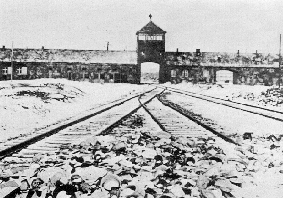

Auschwitz-Birkenau was the death camp set up near the existing concentration and work camps of Auschwitz. Millions of 'undesirables', most of them Jewish, were brought to the camp by trains in cattle trucks. The trains brought them in through this entrance and stopped by a long platform, where the trucks were opened and the people unloaded. Sometimes they were all taken straight to the gas chambers. Sometimes some people were selected to live and work for a while. However, everyone sent to Auschwitz-Birkenau was simply waiting for his or her turn to be gassed.
When Auschwitz-Birkenau was gassing the greatest number of people daily, five crematorium could not cope with the numbers. At this time, and when a crematorium broke down, bodies were loaded into mass graves and burned.
Auschwitz was the most complicated of all the camps. It had a concentration camp (Auschwitz I), a labour camp (Buna/Monowice) and a death camp (Auschwitz-Birkenau). It also had about 40 sub-camps attached to the labour camp. Finally, it had prisoner-of-war camps, close to the factories.
Guards: some 7,000 guards were employed at various times
Victims: the number of people who died at the three Auschwitz camps
between 1941 and 1944 is uncertain, but a commonly accepted total figure is in
the region of one million.
Buildings: 200 wooden huts, each 100 feet by 30 feet
Daily Population: From 30-40,000 to over 120,000
Gas Chambers: Four
Capacity: In the summer of 1944 the camp staff worked 24 hours round the
clock, gassing half a million Hungarian Jews in less than two monrhs.
Employed: About 40,000 slave labourers
Survivors: Less than 15,000 survived